The history of Nusa Penida island in Bali can be traced back to the 10th century. The earliest writings on Nusa Penida have indeed been found on the Belanjong Pillar, which dates back to 914 AD. The inscriptions mention a military expedition by Sri Kesari Warmadewa, the first King of Bali, against Nusa Penida.
The conquest of Nusa Penida and the arrival of the Dutch
Although the people of Nusa Penida had successfully resisted several military expeditions organized by the kings of Bali, the Gelgel dynasty finally conquered the island in the second half of the 17th century. The last king of Nusa Penida, Dalem Bungkut, died in battle during the expedition.
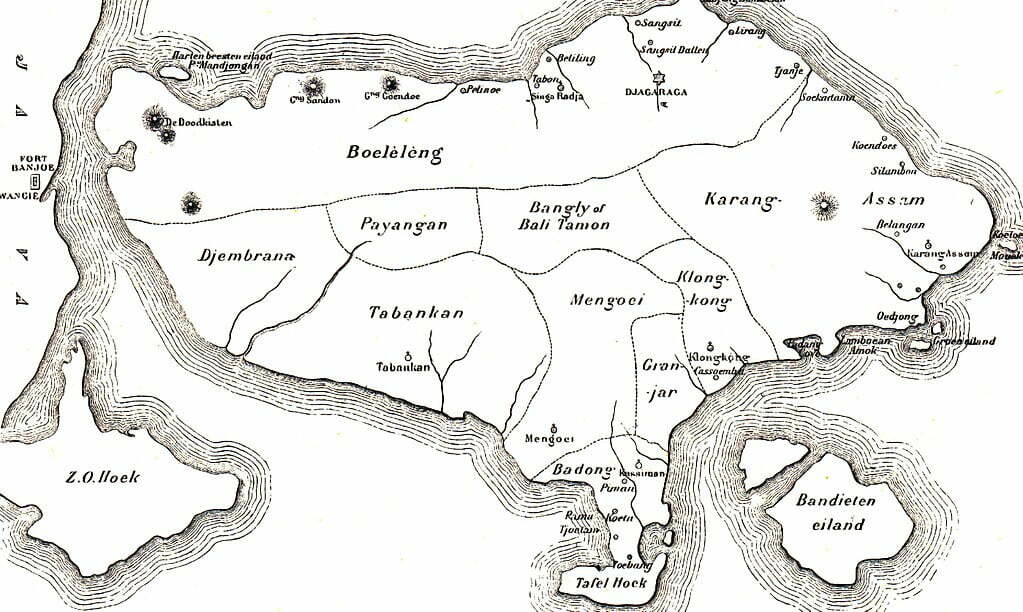
The 7 kingdom of Bali in 1900
Following its conquest, Nusa Penida became a part of the court of Klungkung, which was one of the nine kingdoms of Bali. Even after Bali was integrated into the Dutch East Indies in 1908, and later became part of Indonesia, Nusa Penida remained attached to the Klungkung Regency.
Interestingly, a Dutch map created in 1900 refers to Nusa Penida as the “Bandit Island“. Likely due to the fact that the Klungkung Regency deported its criminals, political opponents, and black magic adepts to the island. This reputation may have contributed to the numerous legends that surround the history of Nusa Penida. As well as its lack of tourism development for an extended period of time!
What is the meaning of Nusa Penida?
Nusa Penida derives from the Balinese language, with “Nusa” meaning “island” and “Penida” meaning “priest”. Hence, Nusa Penida literally translates to “island of priests”. It holds cultural significance due to its name, reflecting the island’s historical connection to Balinese Hinduism. In contrast, the Dutch referred to it as “Bandit Island” in 1900.
The island’s reputation for adventure has also been immortalized in a comic strip by Bob de Moor, published in the Journal of Tintin in 1950. The comic follows the protagonist, Georges Barelli, on his journey to Nusa Penida after a long adventure, as depicted on the album’s cover.
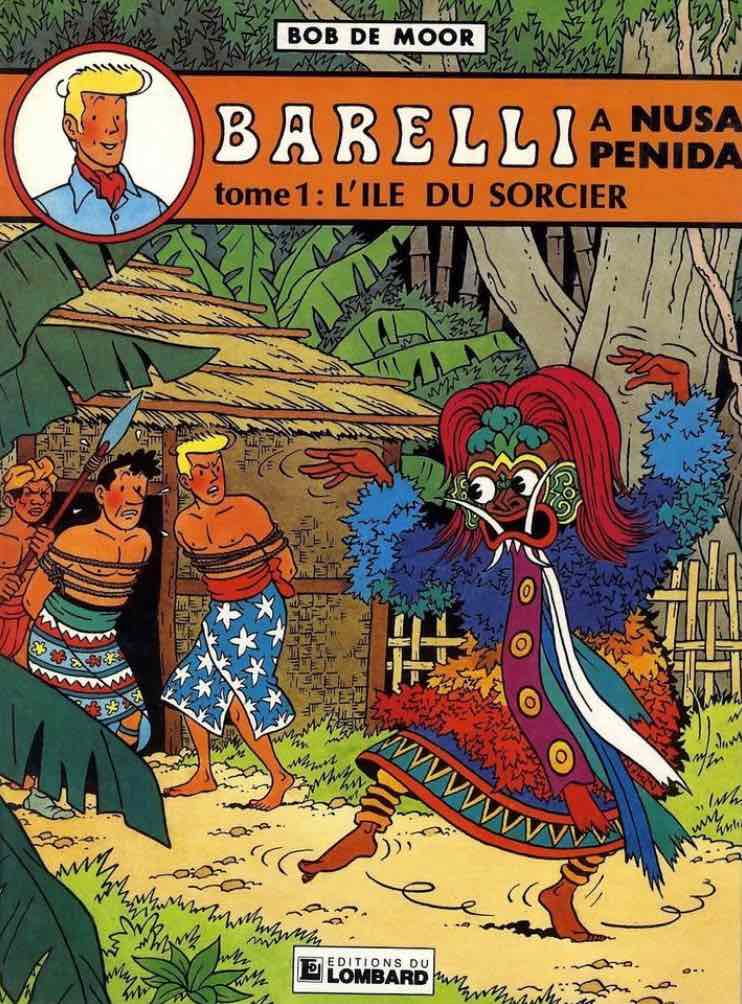
Barelli at Nusa Penida, Sorcerer’s Island
Black magic, an integral part of the history of Nusa Penida
Legend has it that the final ruler of Nusa Penida, Dalem Bungkut, became Ratu Gede Mas Mecaling, the Great Lord with golden fangs, in the afterlife. Another legend suggests that Mecaling was originally from Batuan, a small village in Bali, but was banished to Nusa Penida due to his involvement in black magic. Regardless, his name still evokes fear in some Balinese who avoid speaking it aloud.
Mecaling was a formidable demon known for inflicting diseases and epidemics on the Balinese people out of revenge. On one occasion, during the joyful celebration of Nyepi, Mecaling cunningly disguised himself as Barong, the leader of the good armies. He led his army of demons to wreak havoc and destroy everything in Bali. As a result of this betrayal, the Balinese New Year, Nyepi, is now observed as a day of silence and introspection, in which no noise or merrymaking is allowed, to deceive any returning demons.
The origin of the pilgrimage to Nusa Penida
After the attack, the people of Bali sought the help of a priest who summoned Barong to send Mecaling back to Nusa Penida. The high priests of Gelgel’s kingdom later cleansed the island of dark spirits and banished Mecaling, but his spirit remains at the Ped Temple. This temple is therefore a source of power for those who practice black magic and a place of pilgrimage for those seeking protection from evil and sickness.
Every Hindu in Bali must perform a pilgrimage to Pura Ped Temple in Nusa Penida at least once in their lifetime, where they must strive to find balance between negative and positive energies to achieve calm and harmony.
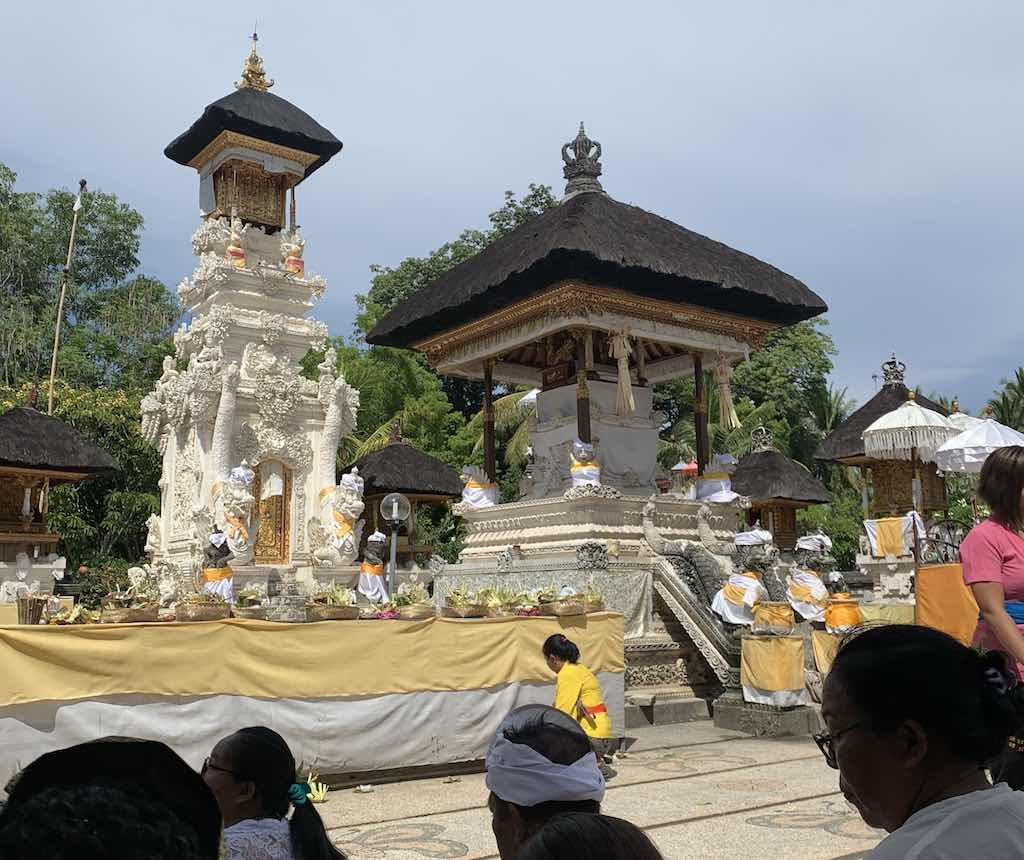
Pura Dalem Ped in Nusa Penida
What are the various types of temples in Bali and Nusa Penida ?
In Bali, temples are referred to as “pura” and there are different types that serve specific functions in Balinese rituals. The term “pura” originates from the Sanskrit word meaning “city” or “palace”.
- The mountainous region of Bali houses the Pura Kahyangan Jagad. Mountains in Bali are indeed considered a sacred and magical realm. The Besakih complex, on Mount Agung, is the most significant Pura Kahyangan in Bali.
- For water management functions and religious activities, Pura Tirta can be found in various villages and cities.
- Pura Desa serves as the center of Balinese religious activities in each village.
- Pura Puseh is dedicated to the worship of Vishnu, while Pura Mrajapati is for the worship of Prajapati, the lord of creation and protector.
- Pura Segara, located by the sea, is important during the Melasti and is used to appease sea Gods and deities. Pura Tanah Lot is an example of this type of temple.
- Pura Dalem is dedicated to the worship of Shiva, Durga, Mother Nature, Banaspatiraja (Barong), Sang Bhuta Diyu, Sang Bhuta Garwa, and other deities. These temples are connected to rituals concerning death.
In Nusa Penida, the most visited temples are Pura Dalem Ped and Pura Goa Giri Putri. Both temples are important places to learn about the culture and history of the island.
Pura Dalem Ped
Pura Dalem Ped is an essential temple complex in the Nusa Penida islands. The Balinese people hold it in high regard as one of the most sacred temples in Bali, owing to its association with the demon king Mecaling. The complex comprises five distinct temples, each with its unique purpose and significance. Towards the north lies Pura Segara, the palace of Batara Baruna, the God of the ocean, located close to the Nusa Strait Sea’s coast. To the south, you will find Pura Taman, a temple garden with a lotus-lined pond, dedicated to purgatory. The western part of the complex is home to the main temple, Penataran Ratu Gede Mecaling. The final two temples are Pelebaan Ratu Mas and Bale Agung.
In December 2019, during the construction of the Adiwana Warnakali Hotel, I visited Pura Dalem Ped for the first time to collect holy water for an essential ceremony. Although I was aware that the ceremonies would take place in four different Pura, it wasn’t until the day progressed that I realized there would be ten ceremonies, each in every temple of the complex. Needless to say, we collected an abundance of holy water for the occasion!
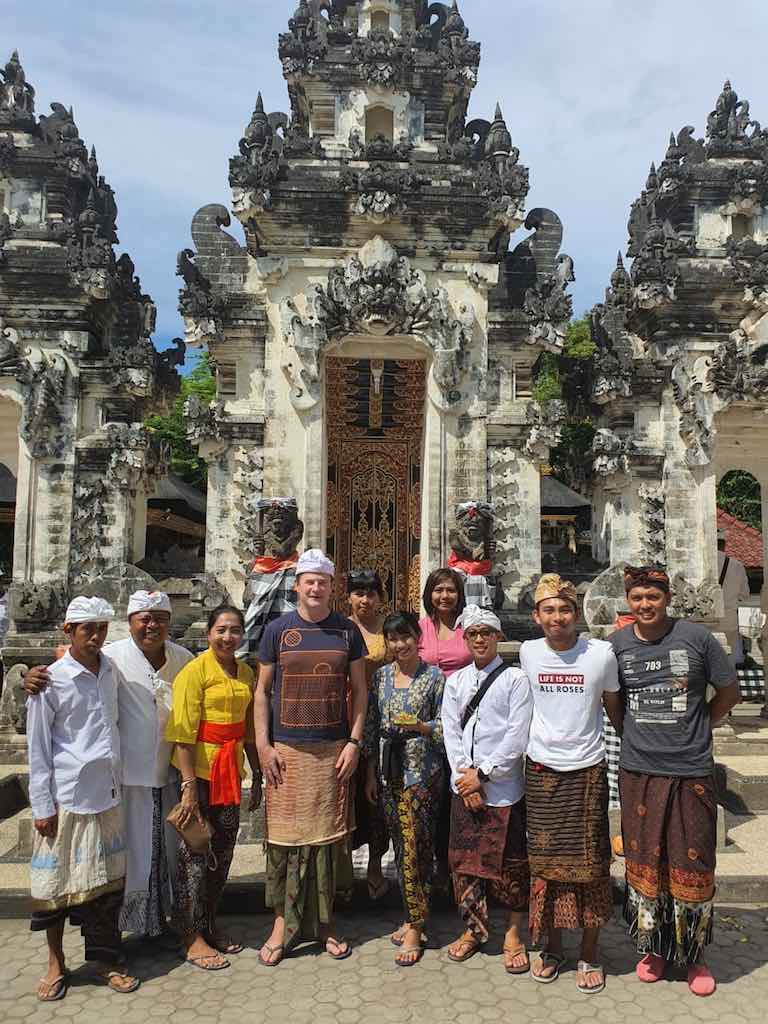
Collecting holy water at Pura Dalem Ped in Nusa Penida
Pura Goa Giri Putri
Pura Goa Giri Putri is an incredible destination among the 15 must-see sites in Nusa Penida island. The cave itself is a remarkable sight. With the name “goa” meaning cave, “giri” meaning hill, and “putri” meaning princess, the cave is devoted mostly to Shiva. In the Hindu triumvirate responsible for the creation, upkeep, and destruction of the world, Shiva is the third god, alongside Brahma and Vishnu. Shiva’s role is to destroy the universe to recreate it. Additionally, the end of the cave houses a shrine dedicated to the Chinese Buddhist goddess of compassion, Guanyin.
Exploring Goa Giri Putri is always an awe-inspiring experience. Don’t forget to participate in the ceremonies at the last temple in the cave. And ask for the famous Balinese red white black bracelet on your wrist.
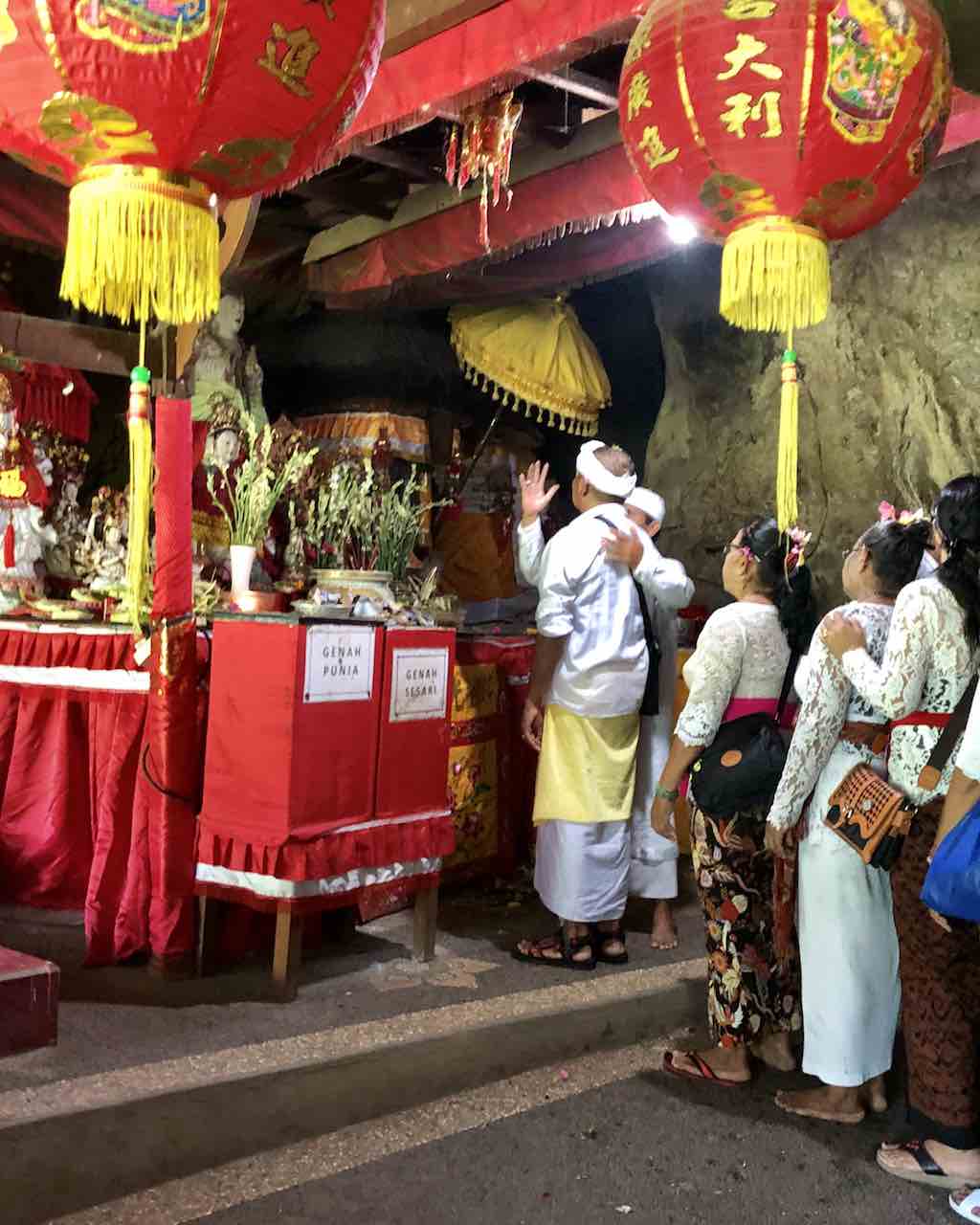
Pura Goa Giri Putri, Nusa Penida
Pura Puncak Mundi
Puncak Mundi Temple stands atop the highest peak of Nusa Penida, soaring over 500 meters above sea level. The road leading to it is well-maintained, offering breathtaking panoramas of the entire island. The surrounding area remains largely untouched, making it a likely habitat for playful monkeys.
The temple’s history dates back to the 50th Saka year (128 AD) when Batara Guru, the manifestation of Lord Shiva, descended upon the Puncak Mundi region and took the form of a priest named Dukuh Jumpungan.
Comprising three temples – Beji Temple, Krangkeng Temple, and Puncak Mundi Temple – Pura Puncak Mundi remains a revered place of worship to this day.
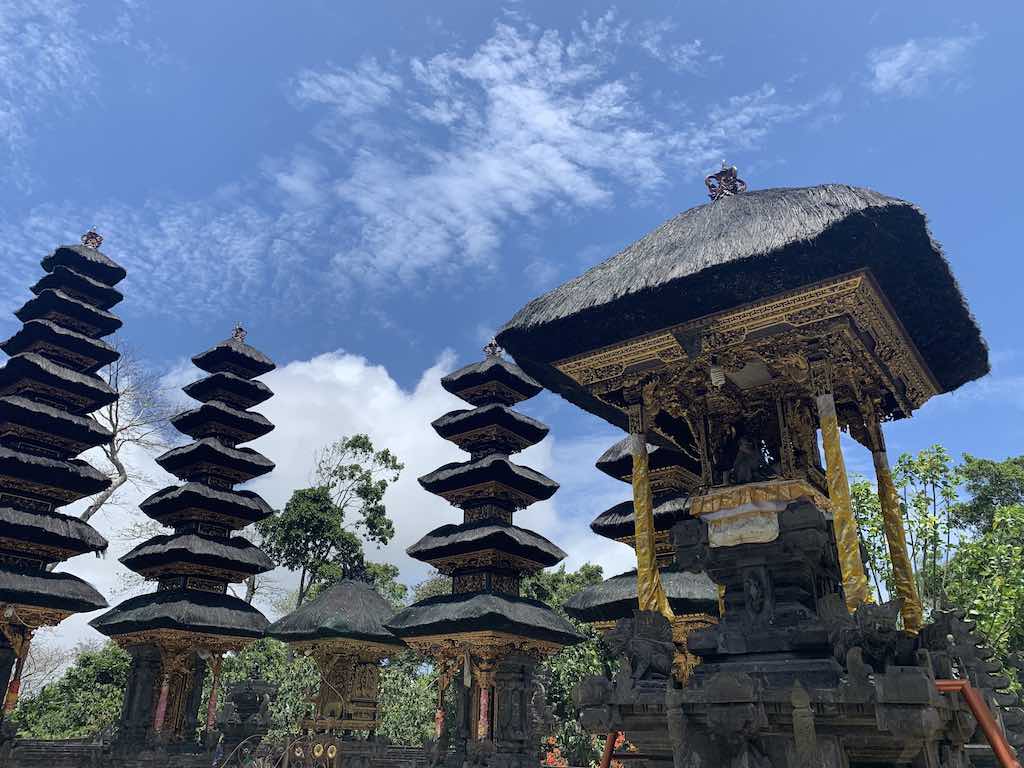
Pura Puncak Mundi
Recommended practices before visiting a temple in Bali
To respectfully enter any holy temple in Bali, it’s advised to wear traditional Balinese attire like a sarong, which can usually be rented on-site. It’s important to maintain a positive mindset and refrain from any disrespectful behavior or language. Additionally, women are requested to avoid entering temples during their menstrual periods as a sign of reverence.
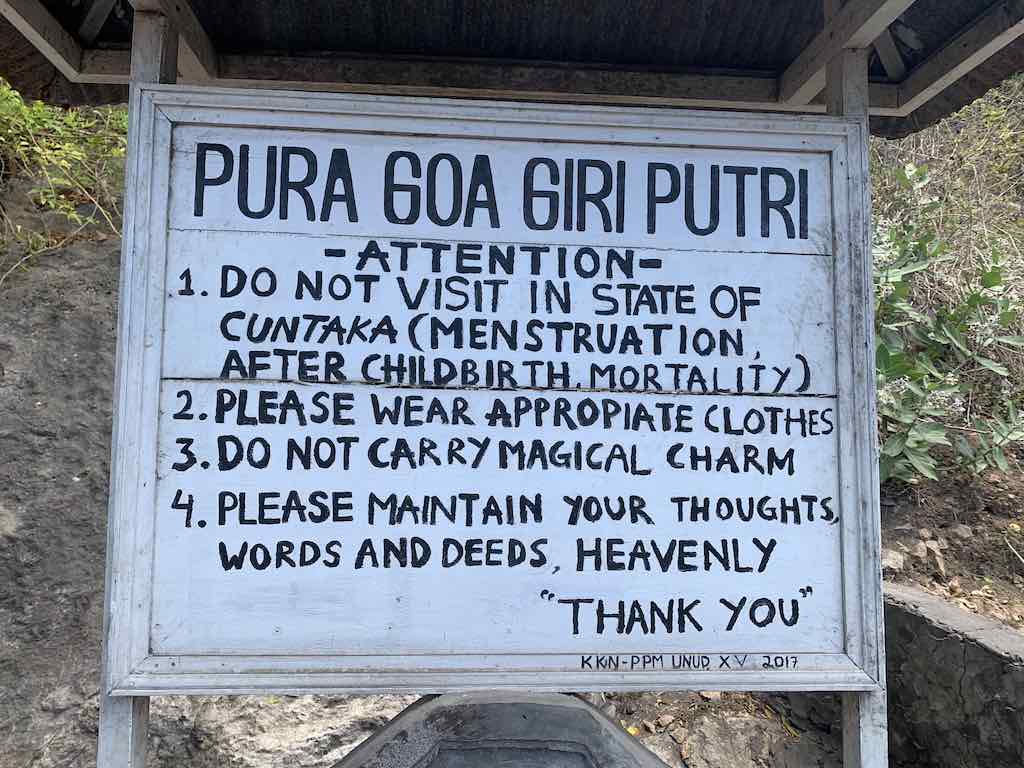
rules to enter in a balinese temple
How to wear a sarong in Bali ?
Wearing a sarong properly is important in the local culture. In Balinese, the sarong is called a kamen. Men and women wear it differently. A woman wrap her sarong from right to left, about one and a half times, ending up over the right hip. The outer layer should fall lower than the inner layer. The sarong should cover the body from hips to ankles. The garment can be held in place by simply tying it, or with a long cord tied to either end. Balinese women usually wear an outer waist corset over the abdomen to help stay neat. A waist sash (senteng) is mandatory for both males and females attending a ceremony or entering a temple. Women wear the sash on the outside of their blouse.
A man will wrap his sarong from left to right around the hips, at around calf-length. Most importantly, it is tied so that the extra cloth falls in the front in a flourish, called a kancut. The kamen is secured by a belt, and over this is worn the obligatory waist sash, often with a secondary hip cloth.
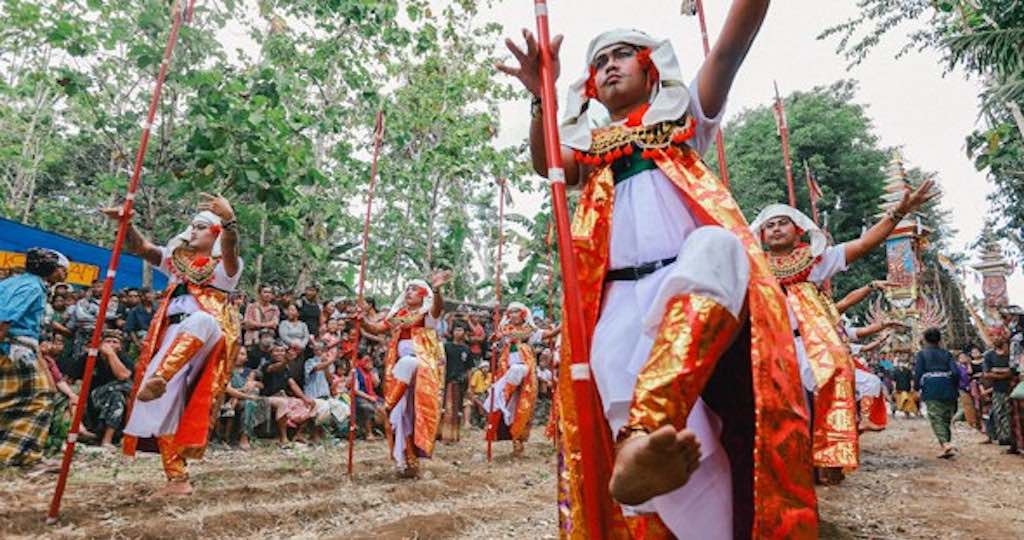
baris jankang dance photo apel photography
Culture of Nusa Penida
Nusa Penida belongs to Bali but it has its own Balinese dialect, which is not spoken anywhere else on Bali. And there are some aspects of the culture of Nusa Penida which are unique.
Baris Jangkang dance
The Baris Jangkang Dance of Nusa Penida is a traditional performance that depicts the demon army that served Dalem Bungkut, the last king of Nusa Penida, in a war against the Balinese King Waturenggong of Gelgel. Dancers wearing the traditional Nusa Penida clothing known as kamben cepuk and wielding long spears take part in the dance.
A national Cultural heritage
This sacred dance is recognized as a National Intangible Cultural Heritage by the Ministry of Education and Culture. The customary village of Pelilit frequently stages it during the piodalan or temple festival. The musical instruments used in the dance include kempul, a pair of gamelan, petuk, cymbals, and dendeng.
You can also witness the Baris Jangkang Dance during the Semarapura Festival.
Some questions ?
If you have some questions about the history of Nusa Penida or the culture in Bali, feel free to ask through a comment or a message. Or go to the dedicated article to find more practical information about Nusa Penida.
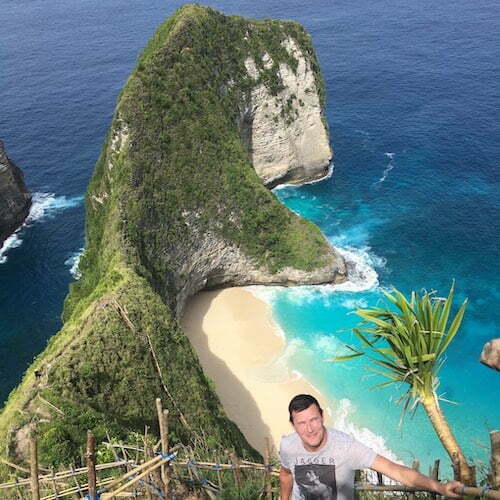 Nusa Penida !
Nusa Penida !